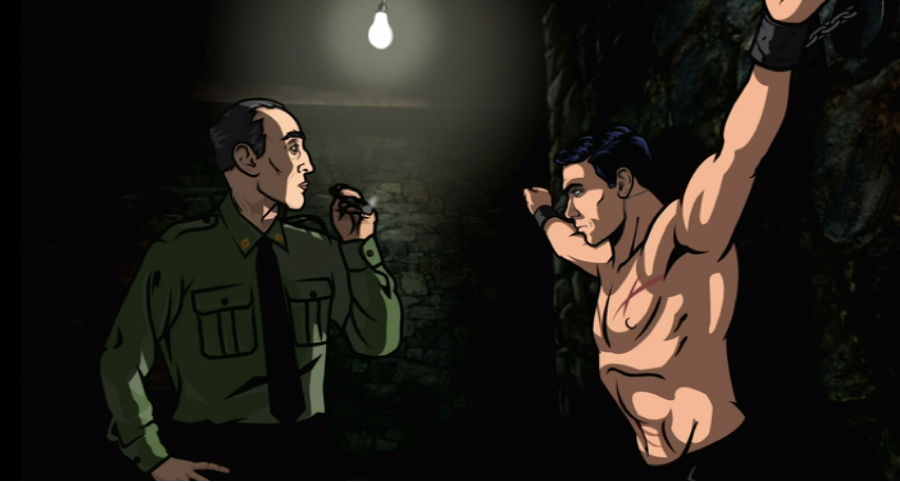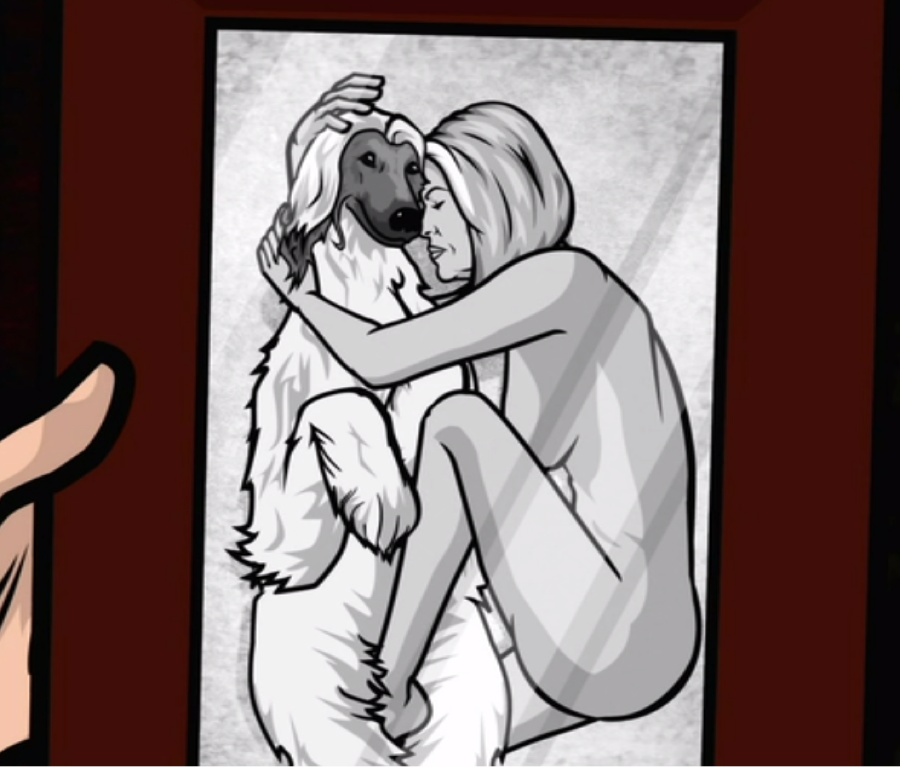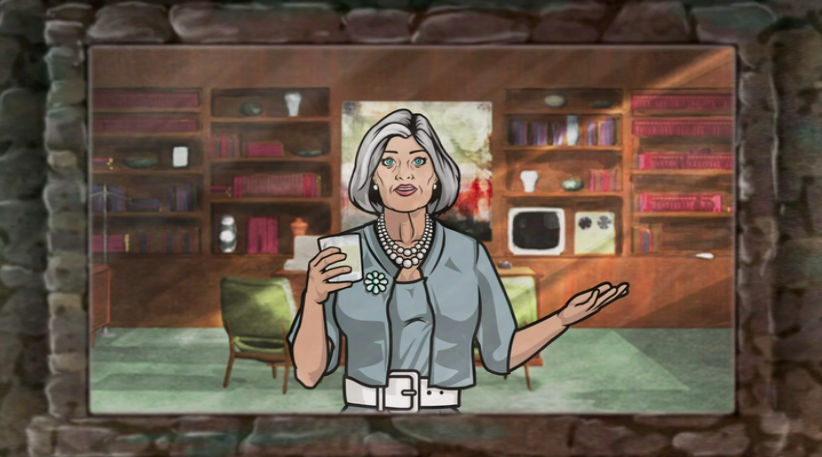Ranking Archer
Matt Sienkiewicz / Boston College

Archer is a trap. It is a tantalizing, glimmering object bobbing in the murky, docu-serial infested waters of non-premium cable. Each 22-minute episode says so much, both with words and images, that the critic salivates instinctually. And, yet, Archer is a perfectly designed lure. The joke is on the biter.
To switch metaphors, Archer is the patient whose mother is a surgeon, who took a few anatomy classes in college, who spent the whole afternoon on WebMD. She may not know more about medicine than her doctor. She does, however, know exactly what to say to lead the expert down a path of her choosing.
Archer’s favorite version of this game is Freudian. Its opening scene screams out a litany of Oedipal themes. Sterling Archer, shirtless, muscled and paradigmatically handsome, dangles from a dungeon wall. An interrogator declares that Archer, codename Dutchess, is “known from Berlin to Bangkok as the world’s most dangerous spy.” The scene’s S&M implications morph quickly into explications. The ostensible spycraft narrative fades away. The scene lights up, revealing the truth. It has all been a show with an audience of one. Sterling’s boss, an elegant, 50-something year old woman, has been watching the torture—a training session—from the start. She is also, of course, Archer’s mother. Dutchess, in addition to being Archer’s nom de guerre, is revealed to be the name of mother’s favorite pet. As the scene cuts out, mother glances longingly at an Annie Leibowitz-style portrait in which she, naked, caresses Dutchess—the dog—in bed.
The scene sends a clear instruction to those viewers who have taken the time to memorize Dr. Freud’s number: page him. It’s all right there. A son takes pleasure in pain, sexualizing himself in front of his mother. The mother displaces the sexual bond of the breast onto another object, claiming that Archer’s codename was “random” i.e. not conscious. Archer, it seems, is luring viewers into a state of comfort through a blend of strange comedy and fantastic animation. It then scratches unconscious itches, giving expression to desires for mother-love that no one dares express in normal, waking life and yet are capable of providing great pleasure. And perhaps it does.
But, perhaps it does not. More than being Freudian, the scene is about Freud, Freud’s place in contemporary humor and Freud’s role in the 1950s culture from which Archer draws its aesthetic. Throughout its run, it has asked viewers to think about Freud when considering Archer’s character. In episode eleven of season three, the script makes this official, with Archer’s on-and-off lover Lana proclaiming: “If you want to know why Archer is Archer, you need to go back in time and have a threesome with Oedipus and Sigmund Freud.” To think overtly about the unconscious, however, is to deny its power. The unconscious is like Keyser Soze’s devil— its power derives from our ability to ignore its existence.

And yet, I cannot help but take a bite at Archer’s psychoanalytic spinnerbait. There is, undeniably, something profoundly dreamlike in Archer’s construction. In addition to the oft-noted surreal qualities of animation, the show’s diagetic landscape is perhaps television’s most comprehensive presentation of the “Kettle logic” that Freud invokes in The Interpretation of Dreams (1978).1 Using the example of a patient’s dream about returning a broken kettle, Freud notes the mysterious, powerful way in which the unconscious supports simultaneous, incompatible states of being. Questioned by his neighbor, the dreamer in Freud’s example offers three explanations: 1. He returned the kettle unbroken 2. The kettle was damaged at the time of his borrowing 3. He had not, in fact, ever borrowed the kettle. Crucially, these are not alternative excuses, as they would be in waking life. In the world of dreams they, somehow, can be simultaneously true, allowing for the unconscious psyche to play out its own contradictory desires and understandings.
Archer’s is a world full of kettles simultaneously borrowed and unborrowed, broken and unbroken. It is a universe in which there are futuristic cellphones, planes, guns and cars. And, yet the Soviet Union and the KGB are going strong. It is a time in which 9/11 has already happened, but Burt Reynolds is still a picture of virility. Archer has an English butler who served in World War I and yet takes supersonic jets to enjoy transgender prostitutes in, of course, Bangkok.
This kettle logic, I submit, is not a commentary on Freud like the mother-love scene that began the series. It is instead a (seemingly unconsciously) attractive way to construct a world in which to play out the complex desires of the unconscious. Yes, some of these are certainly sexual. However, as noted above, the sexual aspects are often tainted by the show’s very intentional invocation of Freudian themes and ideas.

Instead, I turn to the work of Otto Rank, a student and colleague of Freud’s who would, eventually, come to diverge in important ways from his mentor. Rank, who is rarely mentioned in the realm of media theory, represents one of the earliest thinkers to overtly connect the moving screen image with the play of the unconscious. In his 1914 book The Double, Rank (1971) analyzes the film 1913 film The Student of Prague, noting that cinematography “in numerous ways reminds us of the dreamwork (p.4).2 One cannot help but imagine how much Rank’s conviction in this confluence would strengthen were he to see a college student curled up in bed, in the dark, watching seasons of Archer flow from episode to episode as she drifts to sleep.
In his analysis of The Student of Prague, Rank focuses on the literary theme of the double, something he associates with modern man’s desire to maintain a belief in the immortality of the soul in an age the rejects spiritual thinking. However, the heart of Rank’s approach to psychoanalysis resides in what Rankian theorist Ernest Becker (2007) summarizes as “the denial of death.”3 In contrast to Freud, Rank held that people do not, consciously or unconsciously, harbor a desire for their own destruction. Invoking a theory of the psyche in which the conscious mind exercises a greater influence than in Freud’s approach, Rank argued that much, if not all human activity, can be understood through man’s struggle to reject the fact of her mortality. In particular, he argued, dreams can be understood through such a lens. There are two types of dreams pertaining to death, he writes in Psychology and the Soul (2002).4 The first type, in which the dreamer somehow improbably survives danger, denies death by suggesting the subject’s immortality. The second, in which the dreamer either dies or is about to die, also denies death, this time by forcing the subject to awaken and contrast her livingness with a death that has proven illusorily. In either case, the dream serves the dreamer by bolstering her ability to keep death at bay in waking life.
Archer, already taking place in a world that recalls the dream state, consistently invokes themes that play on each of Rank’s dream-types. Nearly every episode features someone, most often Archer, on the absolute brink of death. A lethally poisonous snake bites him, he contracts aggressive breast cancer, he falls into a punji tiger pit. He confronts 99 ways to die, but submits to none of them. Whereas most action series slide into the unrealistic in the construction of gun battles, Archer takes the idea ad absurdum. Every Archer episode recalls Butch and Sundance’s showdown with the Bolivian army. Except in Archer, the army is defeated and the heroes live on.
Other plots hew closer to Rank’s second type of dream, going as far as to kill off characters and then, nearly immediately, return them to life. Barry, Archer’s archrival, dies. So does Archer’s fiancé Katya. There is a moment of shock and mourning but then, just as the dreamer awakes, the dead character returns to life, often as a cyborg, denying death in the process. Such scenes, I submit, are attractive not simply due to the comedic logic of their absurdity, but also their appeal to the viewer’s desire to demote death from inevitability to impossibility.
It is perhaps odd to dismiss Freudian interpretations of Archer while embracing those of Rank, a follower of Freud. However, in this case, Rank’s relative obscurity helps preserve the potentially unconscious nature of the program’s engagement with death themes. Neither writer nor viewer is likely to step back and view Archer’s comedic approach to mortality as a comment on Rankian theories death, while they very well may take the time to make conscious the more obvious Freudian aspects of the show. That, or I’m engaging in my own little denial, believing that I’ve mastered the process of death denial and thus, in some way, controlled the uncontrollable. One never knows.
Image Credits:
1. Archer chained to a dungeon wall in the pilot, Reed, A. (Writer), & Williams, M. (Director). (2010). Mole Hunt [Television series episode]. In N. Holman (Producer), Archer. Irving, Texas: FX Networks, LLC.
2. Archer’s mother and her dog, Dutchess, Reed, A. (Writer), & Williams, M. (Director). (2010). Mole Hunt [Television series episode]. In N. Holman (Producer), Archer. Irving, Texas: FX Networks, LLC.
3. Archer’s mother watching the interrogation, Reed, A. (Writer), & Williams, M. (Director). (2010). Mole Hunt [Television series episode]. In N. Holman (Producer), Archer. Irving, Texas: FX Networks, LLC.
- Freud, S. (1978). The Interpretation of Dreams. Hayes Barton Press. [↩]
- Rank, O. (1971). The Double: A psychoanalytic study. UNC Press Books. [↩]
- Becker, E. (2007). The Denial of Death. Simon and Schuster. [↩]
- Rank, O. (2002). Psychology and the soul: A study of the origin, conceptual evolution, and nature of the soul. JHU Press. [↩]